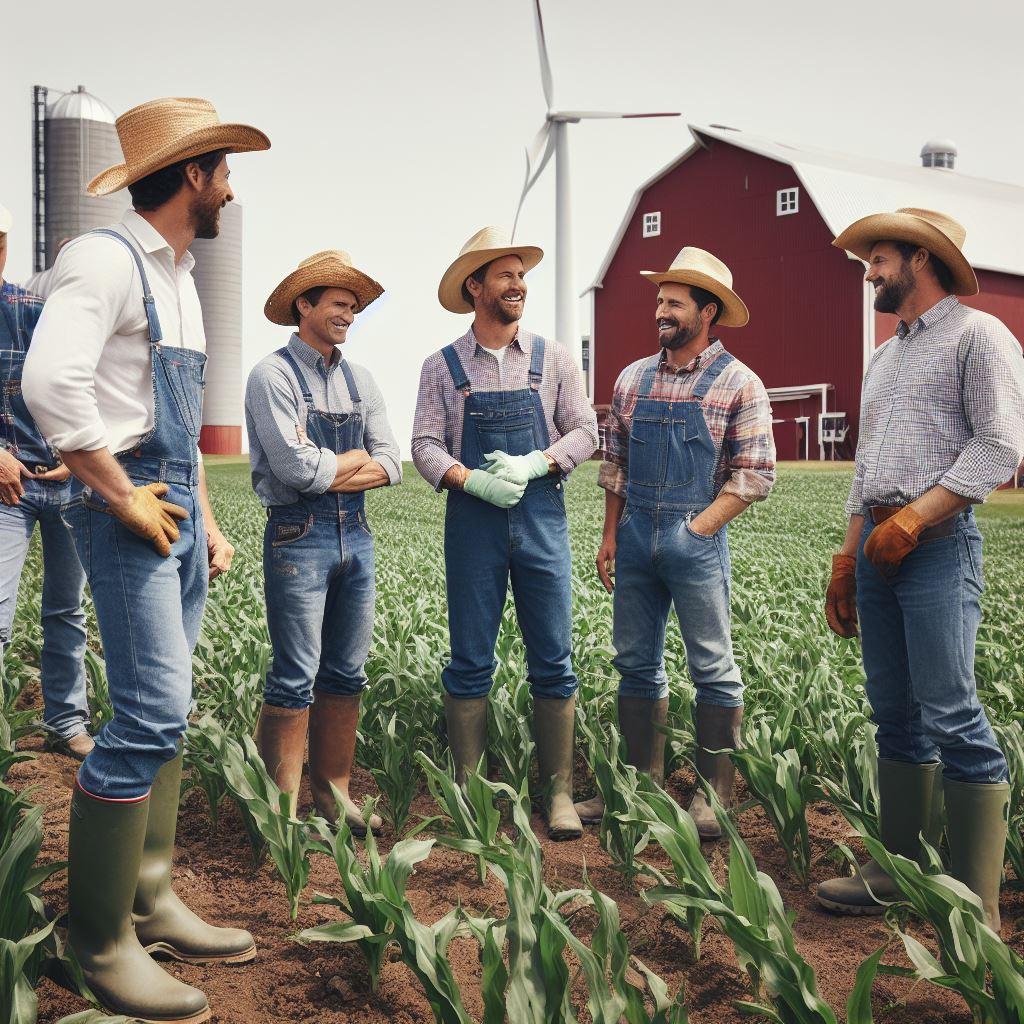Introduction
In this section, we will explore the impact of floods on agriculture and the importance of preparing for them.
Floods can have devastating effects on the agriculture sector, leading to crop damage, soil erosion, and livestock losses.
Therefore, it is crucial for farmers and agricultural communities to be prepared for such events to minimize their negative consequences.
The main points that will be covered in this blog post include understanding the risks associated with floods and their impact on agriculture, implementing preventive measures to protect crops and livestock, and developing emergency response plans to ensure a swift recovery.
By the end of this section, readers will have a comprehensive understanding of the importance of flood preparedness and the steps they can take to safeguard their agricultural operations.
It is essential for farmers to recognize the risks that floods pose to their crops and livestock.
Flooding can lead to waterlogged soil, nutrient leaching, and the spread of diseases.
Implementing preventive measures such as contour plowing, cover cropping, and constructing drainage systems can help mitigate these risks.
Furthermore, developing emergency response plans is crucial for effective flood preparedness.
This includes creating evacuation plans for livestock, ensuring access to reliable weather forecasts, and establishing communication networks with relevant authorities.
In short, floods can have a significant impact on agriculture, causing substantial damage to crops and livestock.
By understanding the risks, implementing preventive measures, and developing emergency response plans, farmers can better prepare for such events and minimize their negative consequences.
In the following sections, we will delve deeper into these topics and provide practical tips for flood preparedness in the agriculture sector.
The Impact of Floods on Agriculture
The destructive nature of floods on farmlands
- Soil erosion and loss of nutrients.
- Damage to crops and livestock.
The economic losses suffered by farmers due to floods
Floods not only wreak havoc on farmlands but also result in significant economic losses for farmers.
The long-term effects of floods on agriculture
Floods have far-reaching consequences on agriculture, affecting both the short-term and long-term sustainability of farming.
Transform Your Agribusiness
Unlock your farm's potential with expert advice tailored to your needs. Get actionable steps that drive real results.
Get StartedFloods are the natural disasters that can cause extensive damage to farmlands.
They bring about various destructive consequences, impacting the agricultural sector on multiple levels.
The first consequence of floods on farmlands is soil erosion.
The powerful force of floodwater washes away the topsoil, which is rich in organic matter and nutrients.
This leads to a significant loss of essential nutrients required for plant growth.
The erosion also alters the soil structure, making it less fertile and less capable of retaining water.
As a result, the long-term productivity of the land is severely affected.
In addition to soil erosion, floods also cause direct damage to crops and livestock.
Floodwaters submerge fields, drown plants, and uproot trees.
Crops, including fruits and vegetables, get destroyed, leading to a loss of the entire year’s harvest.
Moreover, livestock, such as cattle and poultry, can get swept away or suffocate, resulting in a considerable economic loss for farmers.
Besides the immediate impact on crops and livestock, floods cause substantial economic losses for farmers.
The damage to farmlands leads to increased production costs, as farmers need to invest in soil restoration, replanting, and rebuilding farm infrastructure.
Moreover, with the loss of crops and livestock, farmers face a decline in their income, which can push them into financial instability.
The long-term effects of floods on agriculture are even more concerning.
Floods not only disrupt the current farming season but also have lasting implications for the future.
The damage to soil fertility takes a considerable amount of time to recover.
Restoring the soil’s nutrients and structure requires extensive efforts, including soil testing, the application of fertilizers, and proper irrigation management.
This puts an additional burden on farmers in terms of time, labor, and financial resources.
Furthermore, the destruction caused by floods can also lead to a decline in agricultural productivity in the affected regions.
Farmers may choose to shift their focus to other activities or even abandon farming altogether due to the uncertainty and risks associated with flooding.
This can have significant consequences for food security, as reduced agricultural output can lead to shortages and increased food prices.
In essence, floods have a devastating impact on agriculture.
From soil erosion and loss of nutrients to damage to crops and livestock, the destructive nature of floods affects the livelihoods of farmers.
Showcase Your Farming Business
Publish your professional farming services profile on our blog for a one-time fee of $200 and reach a dedicated audience of farmers and agribusiness owners.
Publish Your ProfileThe economic losses suffered by farmers due to floods further compound the challenges they face.
Additionally, the long-term effects of floods on agriculture, including soil degradation and reduced agricultural productivity, pose significant threats to food security.
It is crucial for farmers and policymakers to prioritize flood preparedness and implement measures to mitigate the impacts of floods on agriculture.
Read: Rising Temps: How Crops Struggle and Adapt
Understanding Flood Risks in Agriculture
Factors that Contribute to Flood Risks in Agricultural Areas
- Proximity to rivers, lakes, or coastal areas: The closer a farm is to water bodies, the higher the flood risk.
- Slope and grading of farmlands: Areas with steep slopes or poor drainage are more susceptible to flooding.
- Climate patterns and rainfall intensity: Regions characterized by heavy rainfall or frequent storms are prone to floods
Importance of Assessing Flood Risks on Farms
- Protecting crops, livestock, and farm infrastructure: Assessing flood risks helps in developing strategies to safeguard valuable farm assets.
- Ensuring the safety of farmers and farm workers: Being aware of flood risks allows for timely evacuation and avoids endangering human lives.
Floods pose significant threats to agriculture, with potentially devastating consequences for farmers and the food supply.
Understanding the factors that contribute to flood risks in agricultural areas and assessing these risks on farms are crucial in preparing for the surge.
Agricultural areas located near rivers, lakes, or coastal areas are particularly susceptible to flooding.
The proximity to water bodies increases the likelihood of water overflow, putting farms at risk.
Similarly, the slope and grading of farmlands play a role in flood risks.
Areas with steep slopes or poor drainage systems are more prone to flooding as water accumulates easily.
Climate patterns and rainfall intensity also significantly impact flood risks in agriculture.
Regions with heavy rainfall or frequent storms experience a higher likelihood of floods.
These areas face constant challenges from excessive precipitation, leading to waterlogging and potential crop damage.
Assessing flood risks on farms is essential for the overall protection and sustainability of agricultural operations.
By evaluating the potential risks and vulnerabilities, farmers can implement proactive measures to mitigate damage and losses.
One of the primary reasons for assessing flood risks is to protect crops, livestock, and farm infrastructure. Floodwaters can severely damage crops, rendering them unsuitable for consumption or sale.
Livestock can drown or suffer from stress and disease due to flooding.
Farm structures, such as barns and storage facilities, can be destroyed or severely damaged by floodwaters.
Assessing flood risks allows farmers to develop appropriate strategies, such as implementing drainage systems, constructing flood-resistant structures, or relocating vulnerable assets to higher ground.
Another crucial aspect of assessing flood risks is ensuring the safety of farmers and farm workers.
By being aware of potential flood scenarios, timely evacuation plans can be established.
This prevents personnel from being trapped in dangerous situations and reduces the likelihood of injury or loss of life.
Evacuation routes, emergency communication protocols, and designated safe areas can be identified and communicated to all those involved in farm operations.
Basically, understanding flood risks in agriculture is essential for preparedness and resilience.
Proximity to water bodies, slope and grading of farmlands, and climate patterns all influence flood risks.
Assessing these risks allows farmers to protect their valuable assets, including crops, livestock, and infrastructure.
Additionally, safeguarding the well-being of farmers and farm workers, by establishing evacuation plans and safe areas, is critical in flood-prone regions.
By taking proactive measures, farmers can minimize the impact of floods on agriculture and secure the future of food production.
Read: Future of Farming: Tech against Climate Change

Preparing for Floods: Best Practices for Farmers
Implementing effective drainage systems
- Installing ditches, trenches, and culverts
- Maintaining and cleaning existing drainage channels
Developing a comprehensive flood emergency plan
- Identifying evacuation routes and high ground areas
- Establishing communication channels during floods
Protecting farmlands through soil conservation practices
- Crop rotation and cover cropping
- Terracing and contour plowing techniques
Floods can cause immense damage to agricultural lands, resulting in substantial financial losses for farmers.
Therefore, it is essential for farmers to take proactive measures and implement best practices to prepare for such natural disasters.
Implementing effective drainage systems is crucial in mitigating flood damage on farms.
By installing ditches, trenches, and culverts, excess water can be directed away from fields, preventing saturation and soil erosion.
Regular maintenance and cleaning of existing drainage channels also ensure the continuous flow of water during heavy rains.
Developing a comprehensive flood emergency plan is vital to safeguard farmers, workers, and livestock.
Identifying evacuation routes and high ground areas in advance allows for a quick and organized evacuation process, minimizing the risks involved.
Additionally, establishing effective communication channels, such as radios or emergency alert systems, enables timely updates and coordination during flood situations.
Protecting farmlands through soil conservation practices is another essential aspect of flood preparedness.
Crop rotation and cover cropping techniques enhance soil health and increase its ability to absorb excess water.
By diversifying crops, farmers reduce the vulnerability of their fields to flood damage.
Showcase Your Farming Business
Publish your professional farming services profile on our blog for a one-time fee of $200 and reach a dedicated audience of farmers and agribusiness owners.
Publish Your ProfileSimilarly, terracing and contour plowing techniques help to slow down water runoff and prevent soil erosion, maintaining the integrity of farmlands even during heavy rainfall events.
By implementing these best practices, farmers can significantly reduce the impact of floods on their agricultural operations.
Moreover, these proactive measures contribute to the overall resilience of farms to various climatic challenges.
Drainage systems not only prevent waterlogging and soil erosion but also promote better water management throughout the farm.
Strategic planning and effective execution of drainage infrastructure can effectively reduce flood-related damages, ensuring the continuity of farm operations.
Developing a comprehensive flood emergency plan is not a luxury but a necessity for farmers.
By identifying evacuation routes and high ground areas in advance, farmers can ensure the safety of their teams in case of flooding emergencies.
Establishing communication channels during floods enables quick dissemination of crucial information, enhancing preparedness and coordination.
The role of soil conservation practices in flood preparedness cannot be overstated.
Crop rotation and cover cropping help to improve soil structure and fertility, making the farmlands more resistant to flood damages.
Similarly, terracing and contour plowing techniques minimize erosion, preventing topsoil loss and maintaining the productivity of the land.
Flood preparedness is a crucial aspect of agricultural resilience.
By implementing effective drainage systems, developing flood emergency plans, and adopting soil conservation practices, farmers can minimize the impact of floods on their operations.
It is vital for farmers to prioritize preparation and continuously update their strategies to adapt to changing climatic conditions.
Read: Climate Change: A Real Threat to Global Farming
Collaborating with Agricultural Agencies and Insurance Providers
Agricultural agencies play a crucial role in providing assistance and guidance to farmers in preparing for and recovering from floods.
Collaborating with these agencies can greatly benefit farmers in mitigating the impact of floods on their crops and livestock.
Encouraging farmers to seek assistance and guidance from agricultural agencies
Farmers should be encouraged to reach out to agricultural agencies for support in flood preparedness.
These agencies have a deep understanding of the agricultural sector and can offer valuable advice on flood-resistant agricultural practices.
Furthermore, they can provide resources such as flood risk maps, information on flood-resistant crop varieties, and training on flood management techniques.
The benefits of flood insurance for farmers
Flood insurance is an essential tool for protecting farmers against the financial losses caused by floods.
It is important to educate farmers on the advantages of obtaining flood insurance to safeguard their agricultural operations.
1. Financial protection against flood-related losses
Flood insurance provides farmers with financial compensation for the damage to their crops, livestock, and infrastructure caused by floods.
This compensation can help farmers recover and rebuild their businesses in the aftermath of a flood.
Without flood insurance, farmers may face significant economic losses that can have long-lasting effects on their livelihoods.
2. Assistance with recovery and restoration efforts
Flood insurance policies often include coverage for the costs associated with recovery and restoration efforts following a flood.
This can include expenses related to debris removal, soil remediation, and equipment repair or replacement.
By having flood insurance, farmers can access crucial financial assistance to speed up the recovery process and minimize the impact on their agricultural operations.
In summary, collaborating with agricultural agencies and promoting the benefits of flood insurance are essential in preparing farmers for the surge of floods.
Encouraging farmers to seek assistance from agricultural agencies and obtain flood insurance can significantly enhance their ability to cope with and recover from flood-related disasters.
Read: Innovative Crops: Beating Climate Heat & Drought
Conclusion
This blog post highlighted the potential impacts of floods on agriculture and the need for proactive measures to mitigate the risks.
It is crucial for farmers to prepare in advance by implementing strategies such as building flood-resistant infrastructure and diversifying crops.
Facing flood risks in agriculture can be challenging, but farmers should remember that they are not alone in this journey.
There are support systems and resources available to help them overcome these challenges.
Stay motivated and stay prepared!




